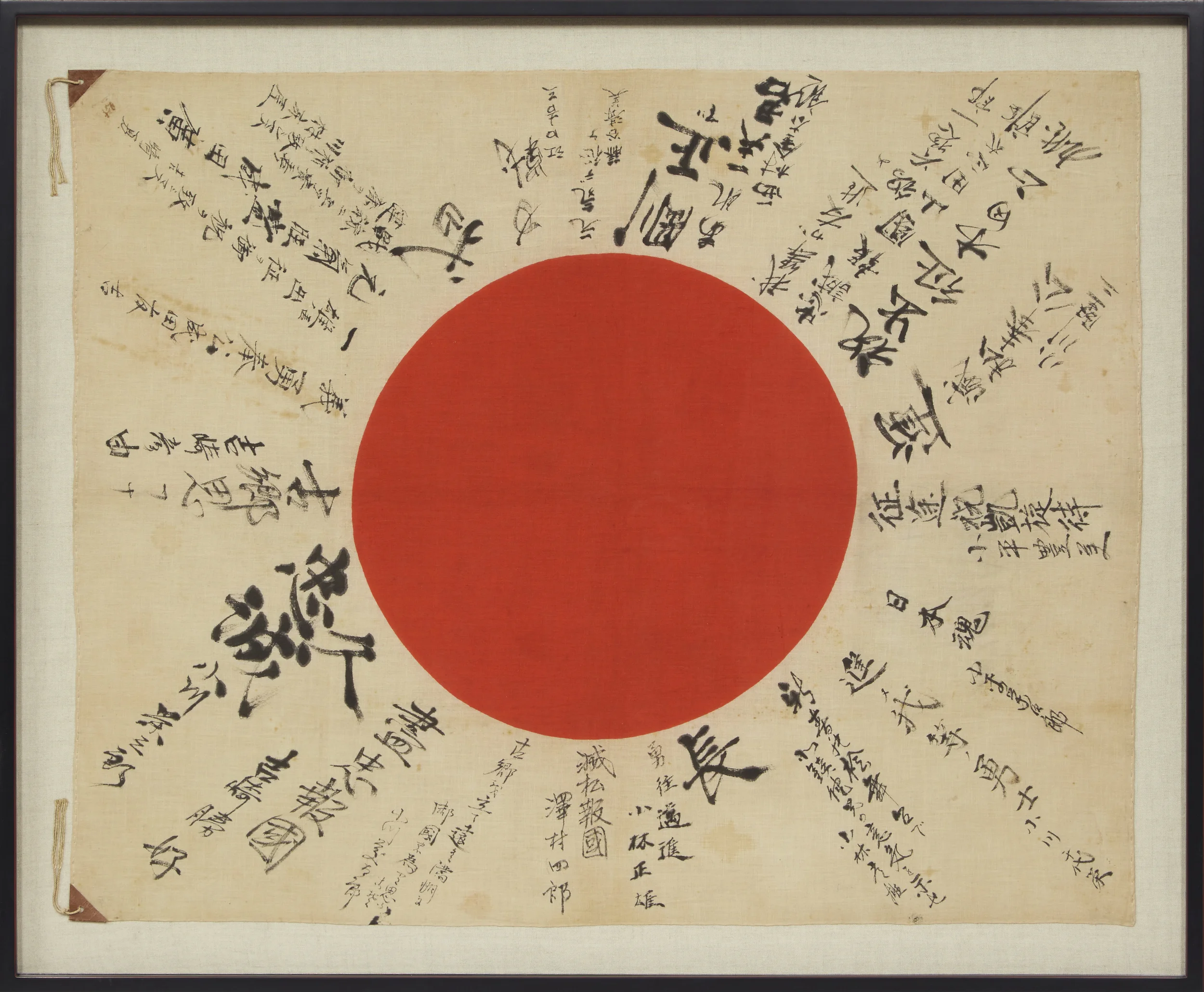November was an exciting month for the city of Chicago, as Cubs fans celebrated the team’s first World Series victory since 1908. Dedicated fans have waited decades, and families loyal to the team have waited generations to see the Cubs crowned World Series champions. Through all of the ups and downs, fans have stuck by the team, collecting memorabilia every step of the way. It comes as no surprise, then, that over the years The Conservation Center has seen a number of Cubs-related works come through the doors for treatment.
The Easel Monument: A Relic from the Civil War
A long time client of The Center, Greg knew just where to bring this 1896 lithograph when he received it from his uncle. And as with most every piece that Greg brings in for conservation, this print has an interesting story to tell about both his family’s history, and the history of the Midwest. A relic from the Civil War, The Easel Monument lithograph tells the story of brothers in arms, an effort to immortalize their bond, and of course, some necessary conservation to preserve it for the future.
Timeless Treatment: Conservation of L’adorazione dei Magi
While The Center is always excited to work on challenging contemporary projects in which new media and methods are used, we still enjoy the oldies and goodies. Recently our Senior Paintings Conservator, Amber Schabdach conserved L’adorazione dei magi, an oil on panel piece circa 1600. L’adorazione dei magi, or The Adoration of the Magi, was brought to The Center to address handling damage.
Cleanliness Is Next to Godliness, Kerry James Marshall
Celebrated artist Kerry James Marshall (b. 1955) has a signature style born from his experiences as an African American growing up during the Civil Rights Movement. For over thirty years, Marshall has created artwork using portraiture that explores the historical artistic representation of African Americans through a wide range of techniques and styles. After earning his B.F.A. in 1978 from the Otis Art Institute in Los Angeles, Marshall settled in Chicago, where now decades later the Museum of Contemporary Art is exhibiting a major retrospective of his work. At this year’s EXPO CHICAGO, The Conservation Center is proud to be featuring the treatment of Kerry James Marshall’s Cleanliness is Next to Godliness in our educational Booth 143.
Mauricio Lasansky and The Nazi Drawings
Objectivity is necessary for conservation; it is a scientific, technical, and calculated field. However, the necessity for objectivity is two-fold as sometimes a conservator must take refuge in objectivity to circumvent becoming immersed in the subject of a work. This was very much the case during the nearly year-long treatment for Mauricio Lasansky's, The Nazi Drawings.
Leon Golub's Burnt Man
After seeing his work for the first time in the 1960’s, Ronald, a client of The Center, has had a deep appreciation for the art of Leon Golub. When a fellow artist personally introduced Ronald and his parents to Golub, they were immediately taken with his work. “When we met him we were so impressed with his technique and his subjects, that we immediately bought three examples of his work.” One of the three paintings, titled Burnt Man, arrived at The Center over fifty years later to undergo treatment for an unstable paint layer.
Italian Landscapes And An American Painter
Earlier this year, two small travel paintings by Grant Wood went up for sale at an auction in Florida. Although they are not the regional subject matter people have come to expect from Wood’s work, these lovely paintings showcase his style while traveling abroad during the 1920’s. Greg, a longtime client of The Center and a collector of American Regionalism art for many years, couldn’t pass on the opportunity to buy these two Wood paintings. “I bought them sight unseen and had them shipped directly to The Conservation Center, as I knew you would do a wonderful job making sure all was well and in order with them.”
The Center In Action: Flood Recovery Efforts in Louisiana
In the wake of disastrous floods that swept through Louisiana, our expertly trained team of art handlers and conservators have once again come to the rescue of an influx of more than 1,600 artworks in desperate need of restoration. As a disaster response resource for art and heirlooms, The Center has responded to countless emergency situations in the past 33 years that require decisive action and expert judgment. The Center has perfected emergency response tactics for a variety of unique situations.
Frederic Clay Bartlett's 56 Panels: A Gothic Chase And Feast
The conservators at The Conservation Center had the rare privilege to conserve a mural in one of Chicago's historic buildings. The University Club of Chicago is a private social club that was founded in 1887 “by university graduates who wanted a special place where they could enjoy intellectual pursuits.” The Club’s current building was constructed in 1907-09 by renowned architectural firm Holabird and Roche, and with its distinct Neo-Gothic facade, it still stands out today amongst the buildings along Chicago’s Michigan Avenue. For the interior spaces, the Club hired fellow member and Chicago artist Frederic Clay Bartlett (1873-1953) to design the interior decor of the club, which included such original artwork as Bartlett’s 56-panel mural on the ceiling of the Club’s Michigan Room.
The Silk Shatter Shaker Bonnet
Traditional and simple, yet beautifully constructed, the style of this Shaker bonnet may lead you to think that it is at least a hundred years old, if not more. Though reminiscent of styles popular in the mid 1800s, according to the owner, “This bonnet belonged to one of the last surviving Shaker sisters at the Canterbury Shaker Village in Canterbury, New Hampshire. It was sold after she passed away, many years ago.” The last Shakers at Canterbury Village might not have passed away as long ago as you think. Eldress Bertha Lindsay and Sister Ethel Hudson, the last two Shaker sisters at Canterbury Village, passed away in the early 1990s; only about 25 years ago.
Out of This World: The Tale of One Lucky Photograph
Here at The Center, we are used to seeing all sorts of artwork and family heirlooms come from worldwide locations, but we’ve never had an item come to us from out of this world! This particular story started off a little something like this…
The countdown began; ten, nine, eight, seven. The family watched as the space shuttle was about to lift from the launch pad; three, two, one, Blast Off!
Weathered Sculptures
The name may not be immediately familiar, but anyone who has spent time walking through the streets of Chicago, will likely recognize the distinctive figurative sculptures of Chicago artist John “Jack” Kearney (1924-2014). Kearney’s sculptures, like those in Oz Park, Chicago, capture a playfulness not always found with public artwork. Kearney trained at the Cranbrook Academy of Art in Bloomfield Hills, Michigan and later at Universita per Stranieri in Perugia, Italy. He became interested in creating artwork using a unique yet common material: chrome automobile bumpers. When his interest sparked in the 1950s, these materials were plentiful, durable, and added an unexpected element to his whimsical animal sculptures.
Norman Lewis, Abstract Expressionist
During the progressive early-mid 20th Century, the genre of Abstract Expressionism became a wildly popular timeperiod in American art history. New York School, as some called the movement, was a way for artists to break traditional and social conventions surrounding the art world, and adopt more emotional expression through abstraction. Among the list of Abstract Expressionist artists was Norman Lewis.
Displaying Waterbodies: A Look into Conservation Collaboration with former Chicago Bear, Israel Idonije
It seemed like any other Wednesday in September at The Center. Things were relatively quiet after a previously hectic week at EXPO CHICAGO, and the Client Services team was expecting an appointment with Israel Idonije who had a large watercolor piece that needed display options. When the client arrived with the watercolor, the team quickly realized that “display options” was an understatement. The Conservation Center prides itself on interdepartmental collaboration and the consultation soon included several conservators from many departments, all of whom were ready to Bear Down and tackle the task at hand.
A Six-Panel Screen and a Panel of Conservators
Whether ancient, contemporary, or any time in between, there are countless types of artwork of all styles and ages that challenge conservators. Every piece of artwork has its own nuances and characteristics that are the result of the artist’s technique, the materials used, and the conditions the artwork experiences over the years. When it comes to conservation there is probably no type of artwork as commonly complex as traditional Asian screens. Typically constructed of paper decorated with paints, gilding, and stretched over a wooden support, Asian screens are a type of object that can require consultations including conservators in many different specialties. Collaboration between paper, furniture, painting, and gilding conservators can be critical to determine the appropriate treatment and achieve successful results when treating Asian screens.
Yosegaki Hinomaru: The Good Luck Flag
Made of delicate fibers, folded, and carried in the pockets of soldiers, Japanese “good luck flags”, commonly known in Japan as yosegaki hinomaru, were parting gifts for soldiers deployed into battle. These flags are evidence of a long standing tradition among Japanese servicemen. The Japanese National Flag, commonly known in Japan as hinomaru, was used to facilitate these messages of prayers and well-wishes from loved ones, so that the soldier could endure the difficult times ahead; yosegaki, refers to the gathered writing, often inscribed in a pattern radiating from the center of the flag. A yosegaki hinomaru experienced only a fraction of the harrowing perils of war experienced by the soldiers who carried them to the front lines. It is remarkable that these flags have survived to continue the story of the soldiers who brought them into battle.
Not Made to Last: A Look at Advertising Banners
Much like newspapers, advertising materials have a definite and distinct shelf-life. Products come and go, and for those companies that do stick around for many years, marketing slogans and styles will change with the times, thus deeming periodic updates to advertising campaigns a necessity. As a result, vintage advertising materials were not made to last for very long: they were constructed with low cost materials and quick reproduction methods that make their survival a rarity. That’s why it is so astounding when items like these banners make it decades remarkably intact. Here’s a look at four advertising banners that have come through the doors at The Center over the years.
Conservation Station: A Behind the Scenes Look at The Conservation Center
When Lake Michigan was Lac des Puans: The Cartographic Origins of the Great Lakes
When Greg brought his map into The Center, he wasn’t seeking conservation work - the map was already in great condition. What it needed was quality framing to properly display it in Greg’s home and keep it safe for another 373 years. That’s right - dating back to 1643, this map of the Great Lakes by Jean Boisseau may not be helpful for travel these days, but will take you on an interesting trip to the past.
Contemporary Conservation and Surreal Artwork: The treatment of two Pedro Friedeberg Sculptures
When asked to describe conservation work, most people think of old discolored paintings and fine art prints with stains and tears - items that need to be treated for decades or even centuries of damage. But time is not a prerequisite for conservation treatment. The reality is that at The Conservation Center, contemporary items arrive at our doors everyday in need of treatment. Recently we had the pleasure of treating two contemporary, functional items by Surrealist artist Pedro Friedeberg.





















